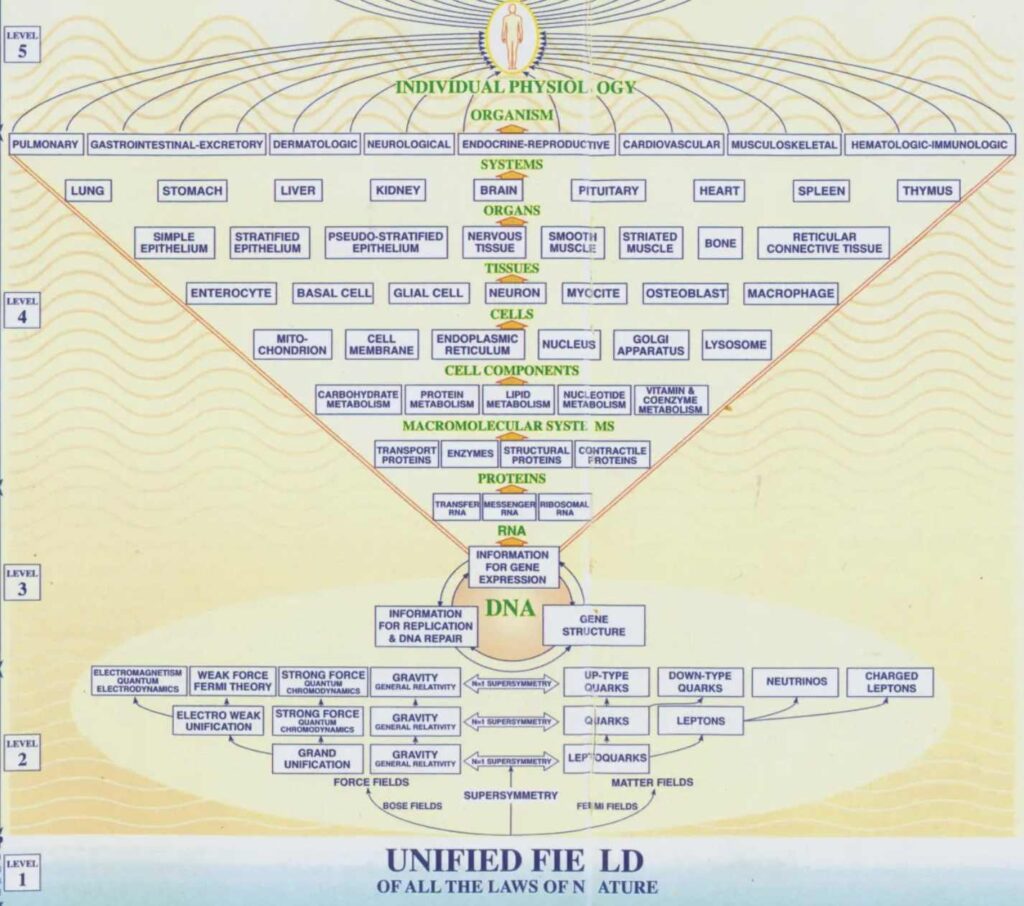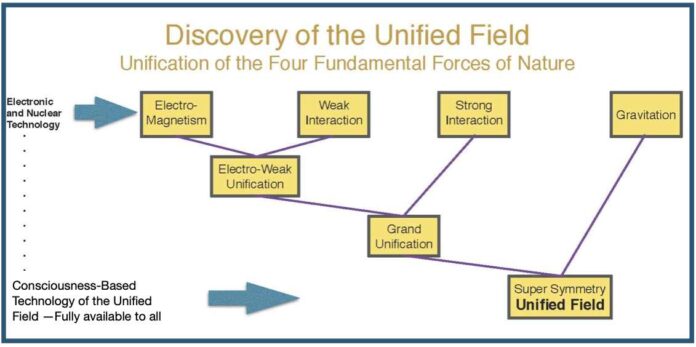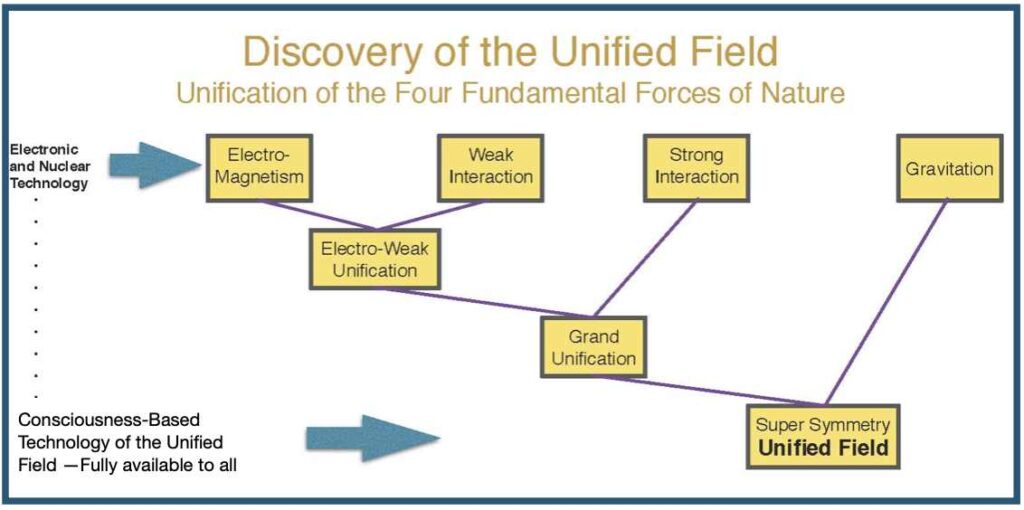|
Getting your Trinity Audio player ready...
|
Social commentators like Neil Oliver and Robert Malone are telling us that something has gone awry in society that needs urgent attention. I probably don’t need to tell you that. It seems to have become incredibly obvious, but what should we do to correct it? What makes a society what it is? How does it function? How can society remain or rather become stable, inclusive, and progressive? From one point of view, society is a kind of collective biological entity, often loosely referred to as a biofield.
The concept of a biofield owes much to our study of plants and animals. Biofields revolve around individual species. Trees of the same species in a forest have been found to participate in mutually supportive networks which sense environmental, nutritional, pathogenic and climatic dangers and then respond appropriately to help one another survive and prosper. Animals of the same species can exhibit cooperative behaviours to forage, hunt or raise young. They often live in communities, packs, herds, etc. Different species are often co-dependent with other species forming food chains for example, together they form larger biofields.
Although we tend to describe communications and shared behaviours in terms of psychological and behavioural concepts, biofields are multidimensional. They involve multiple laws of nature. For example, some birds navigate by sensing magnetic fields. Unique biofields form in geographic places with specific climatic and geographic characteristics. They are influenced by availability and type of food sources. Scarcity of resources and competition for them are also key.
Above all, the defining characteristic of biological entities is their awareness. Biofields are fields that are in some definable sense awake, they involve organisms all of whom register perceptions, take decisions and respond intelligently to their environment. They also do so collectively.
Biological organisms do not behave as purely mechanical systems which are governed by the second law of thermodynamics—the law of universal decay or entropy. The order of biological systems increases rather than decays. In effect, biofields are consuming order from their environment. They do so via their food intake. We are eating order, or in more common parlance intelligence. This natural intelligence takes the form of proteins, vitamins, fats, carbohydrates, etc. all of which originate with DNA.
Biofields are talked about widely, but there is little understanding about what their ultimate physical basis might be. Certainly, DNA is embedded in the underlying universal laws of nature described by physics. There are four fundamental force fields quantified by physics—gravity, electromagnetism, weak and strong nuclear. As you go to finer time and distance scales, these become progressively more unified into a super symmetric framework. A unified field theorised at the Plank scale has to be described by non-abelian mathematics—it creates time, space, and matter from within itself. This self-referral quality of theoretically conceived unified fields has led some physicists to equate them with consciousness.
Every material object is connected to a more abstract and subtle reality that, at the most refined level of natural law—the Planck Scale of 10-33 cms, has the characteristics of consciousness. This understanding raises some fascinating speculations about biofields. Are they essentially networks of consciousness? Is our biological self at root a structure made out of consciousness which operates from the most universal and unified level of natural law? At first glance there would appear to be no objective experimental ramifications of this idea. The physical energies required to excite unified fields are close to the total energy of the universe.
Yet by implication, the key to investigation of biofields could lie with a greater understanding of consciousness, which fortunately is close at hand—our own self—fully available to everyone.
Organisms in biological systems have individual characteristics, each has a unique identity. Even plants vary slightly from one specimen to another. Every biological entity is paired with a genetic identity, which varies slightly from one to another. These genetic structures which define species and their individual members are embedded in the wider laws discovered by physics which are universal.
Genetic structures bridge the gulf between the universal and the individual, amply illustrated by the following diagram.

Genetic similarities are key drivers of biofield membership.
At this point we have to pause for thought. Modern science separates consciousness and matter, it ignores the first and gives primary status to the second. Yet we have biofields whose twin defining characteristics are genetic similarity and the capacity to be awake—body and mind, two sides of one coin. When we come to describe biofields of humans—society—we talk in terms of psychology, history, economics, behaviour, the built environment, climate, governance, etc. The closest we get to genetics is to mention ethnic origins, a concept whose importance we quite rightly wish to minimise.
At the heart of society is the family. Biofields are glued together by genetic and behavioural similarities inherited in family groups. What is the role of genetics in biofields in a strictly scientific rather than social sense?
Critical evidence is very close to hand. Trillions of cells in our body support a single human identity. How they do so is very much an unsolved scientific mystery, but certainly for each individual every single cell contains identical genetic information. Trillions of genetically identical cells have the capacity to communicate and support a single conscious organism with a unique self-identity. The gene/consciousness axis in the human body supports an identity which relies on genetic similarity. Does this point to not just some sort of individual consciousness field formation via the physiology, but also between organisms of the same species?
I first began to think about this because of my background in physics and because of research conducted on human networks.
The phenomenon of quantum entanglement shows that memory is a characteristic of physical particles. At an atomic level, past interactions or events can lead to enduring connections that are even maintained at a physical distance across space and time. This might be relevant, although the application of quantum mechanical principles to something as large as a biological organism is currently no more than speculation.
It is my research on something known as the Maharishi Effect (ME) that throws up some huge questions about how humans form networks whose members can share common characteristics or behaviours. There have been over 55 studies of the effect published to date. I completed three of these (see here and here). Simply put, when approximately one per cent of a population practices deep meditation, there are measurable effects of increased orderliness in the wider population including reduced crime and increased economic activity. I have written extensively on this in chapters 11-13 of my book Your DNA Diet.
With reference to biofields, the most unusual characteristic of this effect is the fact that a population’s behaviour in a locality is influenced by the state of mind of its members whether they know or meet each other or not. The statistical certainty of this relationship is very high indeed. How does that happen? I am grateful to a suggestion made by Maharishi at a conference I attended in 1975 in Switzerland—genetic similarity could be relevant to the spread of the effect. It could be described as a sort of genetic resonance of consciousness within a biofield.
Recently I have reviewed many of the published ME papers and realised that populations with tighter genetic links show more geographically focused effects of meditation by its members, whereas populations with greater genetic diversity have more diffused effects.
For example, a meditation project among a village population in Lebanon with settled roots found a strong localised reduction in conflict intensity, whereas a study of a meditation group in Iowa found an effect of reduced violent crime diffused throughout the USA which has a genetically diversified population. My study in Merseyside, including the port city of Liverpool, much of whose population shares definably similar genetic roots, showed a strong effect of crime reduction driven partly by local participation. Whereas a study in Washington DC required a much larger group of meditators imported temporarily into the US capital to produce a similar sized effect.
It is important to emphasise that this is not a religious or cultural concept. Deep meditation is associated with reductions in metabolic rate (deep rest) and increases in brain wave coherence. This is not the result of belief. Studies show systematic instruction and long term practice improve the health and immunity of the individual. ME is a technology to leverage the relationship between individual consciousness and collective consciousness, between individual physiology and the physiology of society. The effects are measurable and repeatable and thus open to scientific investigation and verification.
There is an extraordinary conclusion here that points to the need to expand our current models of social networks.
What does this tell us about biofields? We appear to share subtle connections with our family members and our wider whanau which can play a cohesive role in society. We are affected by every level of natural law, not just gravitational forces and electromagnetism, but also by climate, geography, sunshine, food, the built environment, microorganisms, etc. Direct communication, information, and emotional support are all crucial, but we can also say that our genetic structure is closely linked to individual consciousness. Therefore our social relationships could be modified by our genetic relationships. These relationships have historical roots.
Do we move among unseen genetic ties which stem from historical events?This is an interesting idea and one that receives support from numerous cultural traditions including the Maori understanding of whakapapa. Related ideas have been articulated by Rupert Sheldrake. The philosophers of ancient India name this phenomenon ‘family dharma’—the destiny of families. We have individual purposes, but also collective purposes. Dharma also refers to that which is right action. Family well being is said to be secured through the right action of its members. Our historical connections are said to be both unfathomable, yet fundamental to the health of society. The highest individual dharma is considered to be ‘knowing the self’ something that finds echoes in almost every cultural tradition from the Socrates’ injunction to ‘know thyself’ to Christ ‘the Kingdom of God is within you’.
We are at a crossroads. We need to find safe ways ahead.
Earlier this week we published an article “Twenty Reasons Biotechnology Experimentation Should Be Outlawed”. We explained that biotechnology is inherently mutagenic. It would be a mistake to think that the fundamental risks of genetic modification can be fixed by more advanced or supposedly exact technology such CRISPR techniques. Today we know this to be a false flag. A paper published in November 2022 by the Karolinska Institute shows that CRISPR/cas9 techniques lead to unpredictable on-target genetic rearrangement which can interfere with vital cellular gene repair mechanisms.
Gene-based bio-manufacturing is similarly inexact and inherently risky. Poor batch uniformity and contamination has plagued the mRNA Covid vaccine rollout. These problems are not fixable, because genes are dynamically self-replicating. Without the tight regulatory mechanisms inherent in natural in-vivo cells of the physiology, problems can and do rapidly multiply during the bio-manufacturing processes in unpredictable and uncontrollable ways.
We are on the cusp of biotechnology-dominated medicine.
The UK Telegraph describes the lucrative profits of biotech medicine as a gold rush, braying for example:
“While the development of Covid-19 vaccines and treatments was a huge money maker for companies such as Pfizer, it has proved temporary. The market for weight loss jabs has much more staying power.”
I can’t understand how the media can so casually equate massive pharmaceutical industry profits with national progress. Like the Covid vaccines, these novel weight loss injections have horrific and sometimes deadly side effects. Once started, you are on them for life. They inhibit digestion, the basis of health. But such is the political and media clout of the pharmaceutical industry no one seems to be willing to sound the alarm.
On the other side, more and more research is revealing the benefits of a natural diet and lifestyle.I think you will agree that reductions in indicators measuring societal problems like rates of crime, hospitalisation and accidents, along with improvements in measures of well-being like economic activity, happiness, longevity, freedom from chronic illness, etc. should be yardsticks to measure the success of governments. There is no doubt that we are failing on these right now. The announced plan to remove taxation from fresh fruit and vegetables in New Zealand is a small step in the right direction. More are needed, although these are more likely to be taken as a result of personal decisions, rather than political initiatives from any party.
This is not going to be a choice where anyone can sit on the sidelines or play both sides. Two paths are diverging. One offers the supposed convenience of pills and shots. It entails long term dependency on biotechnology which carries with it a high rate of side effects. The other requires a more focused and committed approach to the routines of daily life and new personal skills.
Despite this, the apparent choice of life paths that we face could be to a large extent an illusion. Biotech interventions are already a part of veterinary protocols and widely used in agriculture, whereby they are entering our food supply. Genetic material is highly mobile. The pandemic should have taught us that genetic modification is uncontainable. New Zealand tried its best to escape the pandemic by closing its borders. It didn’t work. From this perspective there is really no way out of the impending tsunami of genetic mutation except Global Legislation Outlawing Biotechnology Experimentation
My purpose in writing this article is to suggest that we have just been treated as a society to mRNA injections which are designed to alter the way DNA expresses itself. This has been a mass genetic intervention. This appears to have modified the subtle connections that support the health of the individual, the family, and society. Setting this right may include improvements to our diet and an approach to education that enables us to develop our consciousness, but it must also include a ban on biotech experimentation. Modern life, government interventions, and computer technology are weakening the bonds of family and community, leading to a greater sense of isolation. We need to stick together.
We have been talking in this article about the constitutional principles of nature, how biological systems are set up and how they function. These are not principles that can be altered by government decree or modified by political ideas, but they can be disrupted by genetic modification.
At stake here is our genetic integrity and our connection with the universal. Body and mind are two sides of one coin, both in need of protection and nourishment.
You can read more about this perspective in my book Your DNA Diet and in my paper Evolution, Genetics, Physics, and Consciousness






